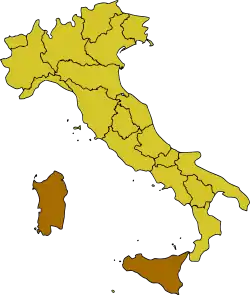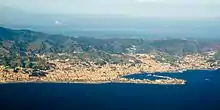Insular Italy
| |
|---|---|
 | |
| Composition | |
| Area | |
| • Total | 49,801 km2 (19,228 sq mi) |
| Population | |
| • Estimate (2022) | 6,377,044[1] |
Insular Italy (Italian: Italia insulare or just Isole, meaning "islands") is one of the five official statistical regions of Italy used by the National Institute of Statistics (ISTAT), a first level NUTS region and a European Parliament constituency. Insular Italy encompasses two of the country's 20 regions: Sardinia and Sicily.
Geography
Insular Italy occupies one sixth of the national territory in surface area. Territorially, both Sicily and Sardinia include several minor islands and archipelagoes that are administratively dependent on the mother islands.
Sicily is the largest island in the Mediterranean (25,708 km2) and one of the largest of Europe, while Sardinia is only slightly less extensive (24,090 km2). The lowlands are generally limited in the geographic region and generally appear as narrow coastal belts. The only exceptions are the Campidano and Nurra, in Sardinia, and the Plain of Catania, in Sicily, which extend 1200 km2 and 430 km,2 respectively. The rest of the area is prevalently hilly, with hills occupying 70% of the territory.
Sicily is home to Mount Etna, Italy's highest non-Alpine peak and Europe's largest active volcano. Sardinia is home to the Gennargentu mountain range.
Demographics
The population of Insular Italy totals around 6.4 million residents, just over one-tenth of the national population and by far the lowest of all the country's macro-regions. While it is the smallest macro-region in area, the region also has the lowest population density. This is because of the scarce population of Sardinia, one of the least densely populated parts of Italy at only around one-third of Italy's average population density. The islands are of roughly the same size but three quarters of the region's population lives in Sicily. In 2022, the population resident in Insular Italy amounts to 6,377,044 inhabitants.[1]
Regions
| Region | Capital | Inhabitants |
|---|---|---|
| Cagliari | 1,575,028 | |
| Palermo | 4,802,016 |
Most populous municipalities
Below is the list of the population residing in 2022 in municipalities with more than 50,000 inhabitants:[1]
| # | Municipality | Region | Inhabitants |
|---|---|---|---|
| 1 | Palermo | 630,167 | |
| 2 | Catania | 298,762 | |
| 3 | Messina | 218,786 | |
| 4 | Cagliari | 148,117 | |
| 5 | Sassari | 121,021 | |
| 6 | Syracuse | 116,244 | |
| 7 | Marsala | 79,809 | |
| 8 | Ragusa | 73,159 | |
| 9 | Gela | 71,217 | |
| 10 | Quartu Sant'Elena | 68,585 | |
| 11 | Vittoria | 63,316 | |
| 12 | Olbia | 61,048 | |
| 13 | Caltanissetta | 58,532 | |
| 14 | Trapani | 55,559 | |
| 15 | Agrigento | 55,512 | |
| 16 | Modica | 53,503 | |
| 17 | Bagheria | 52,928 | |
| 18 | Acireale | 50,515 | |
| 19 | Mazara del Vallo | 50,039 |
Economy
The gross domestic product (GDP) of the region was 123.9 billion euros in 2018, accounting for 7% of Italy's economic output. The GDP per capita adjusted for purchasing power was 18,500 euros or 62% of the EU27 average in the same year.[2]
Socio-economic situation
The unemployment rate of Sicily is the highest in the country at 11.9%, while in Sardinia between 2006-07 it dropped for the first time below 10%, reaching 8.6%, the lowest of all the Mezzogiorno regions, excluding Molise and Abruzzo.
The low level of entrepreneurship in Sicily is tied to the local organized criminal activity, and in Sardinia, it results from the rather expensive operating expenses (electricity, transportation etc.), which are 20-50% higher than other regions because of its peripheral location from the Italian mainland and the lack of a proper territorial continuity (continuità territoriale). That condition has been reduced in Sardinia with the development of information technologies like Tiscali low-cost carriers like Ryanair and laws regarding fares and routes between the islands and mainland Italy.
See also
References
- 1 2 3 "Dato Istat al 31 dicembre 2022". Retrieved 24 March 2023.
- ↑ "Regional GDP per capita ranged from 30% to 263% of the EU average in 2018". Eurostat.



